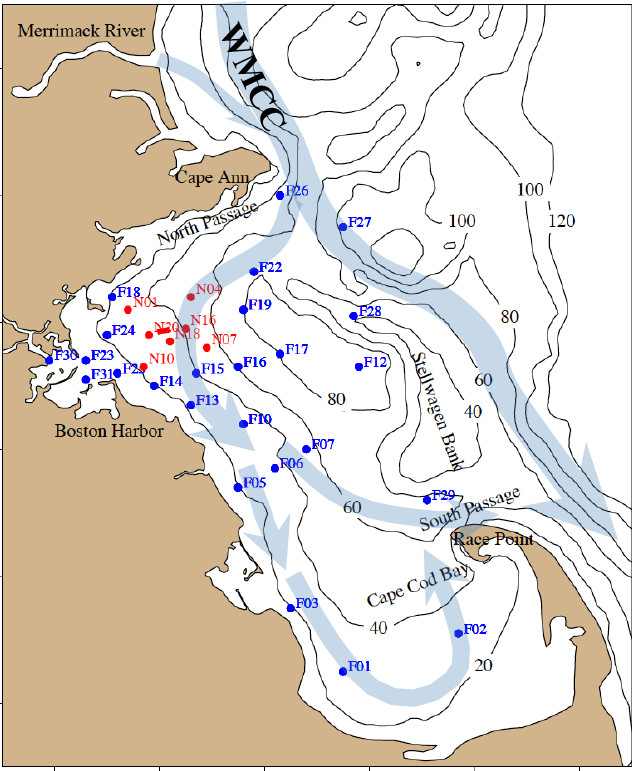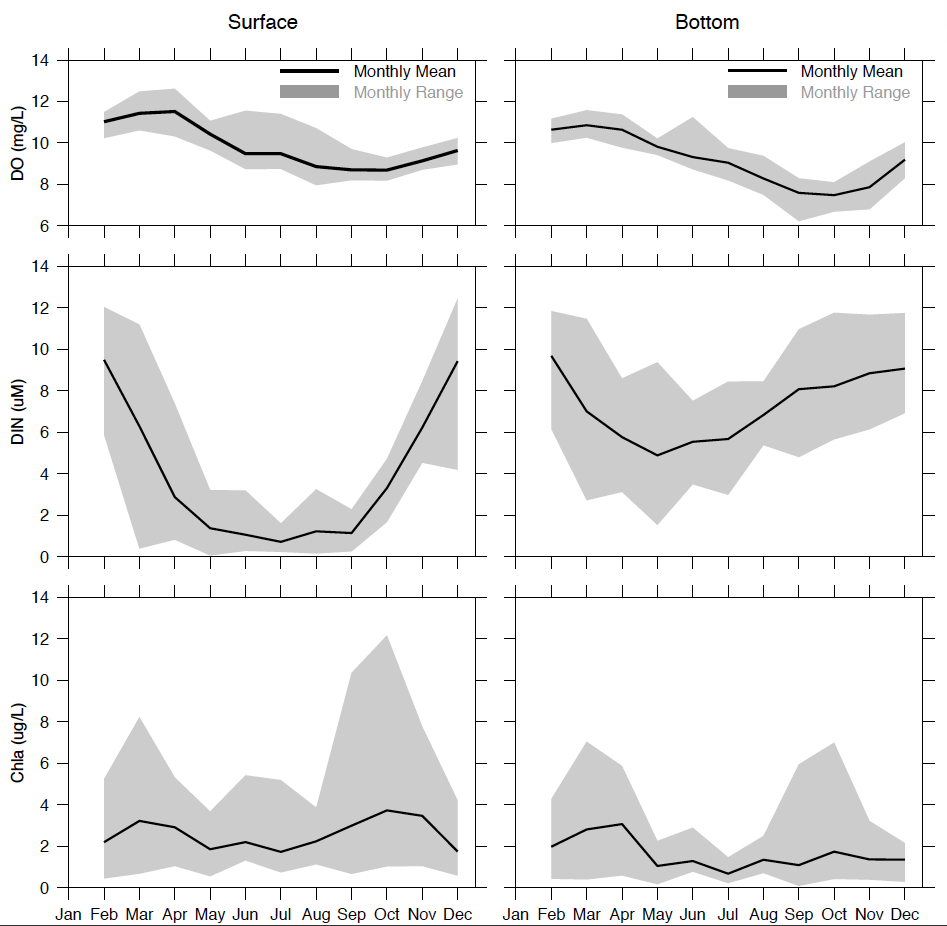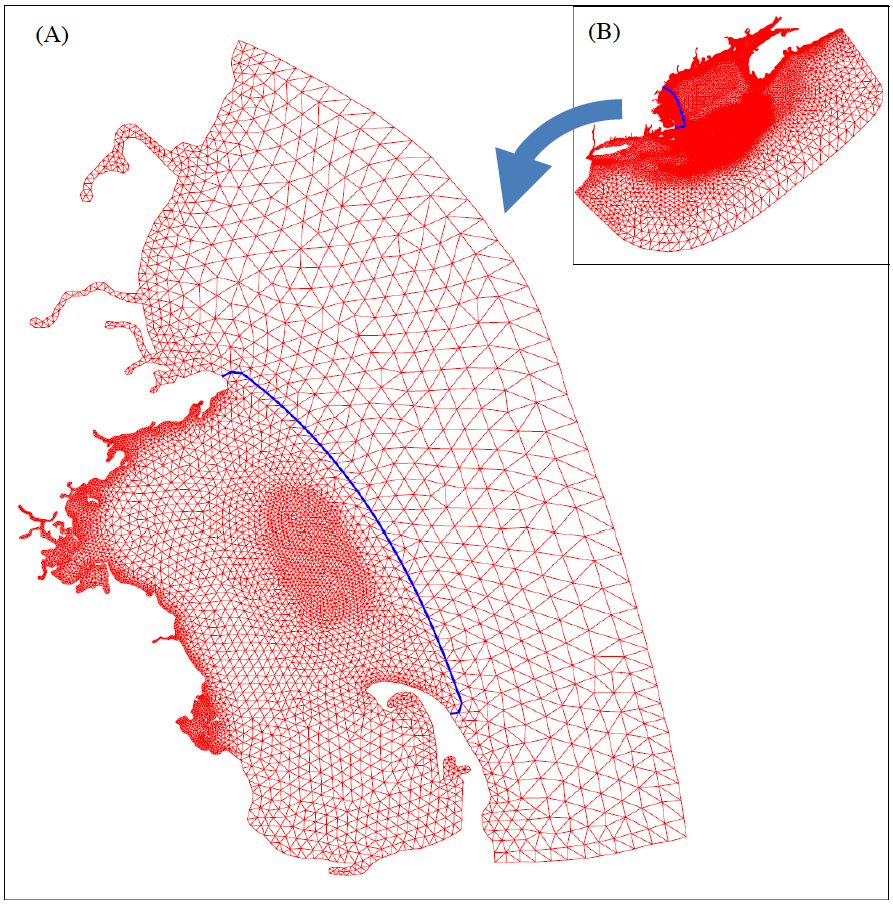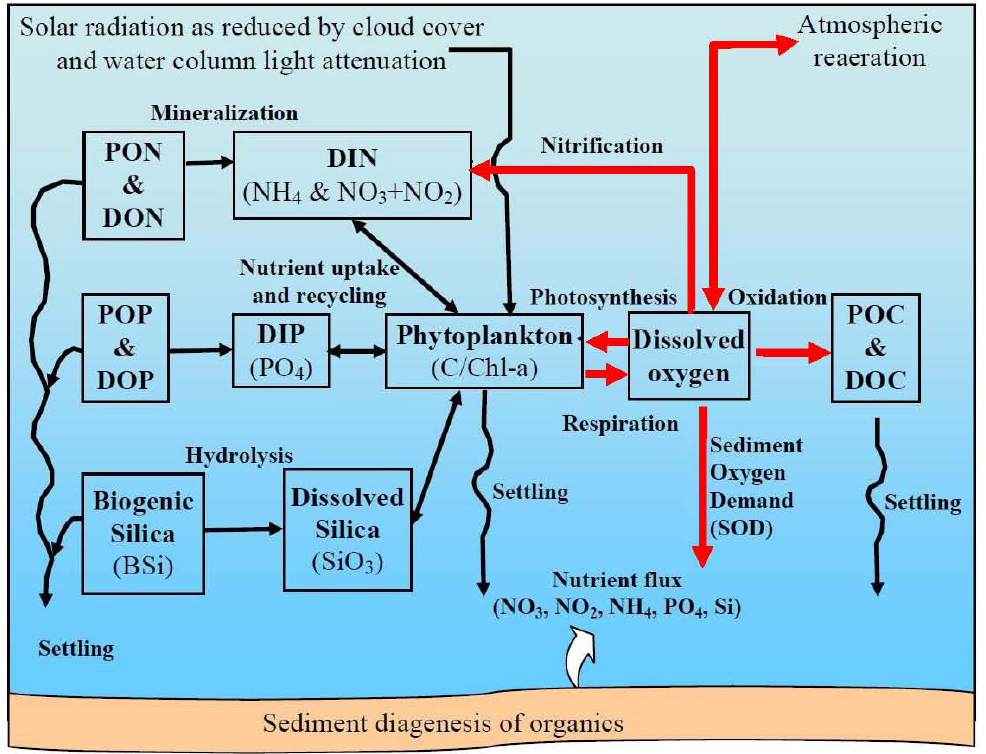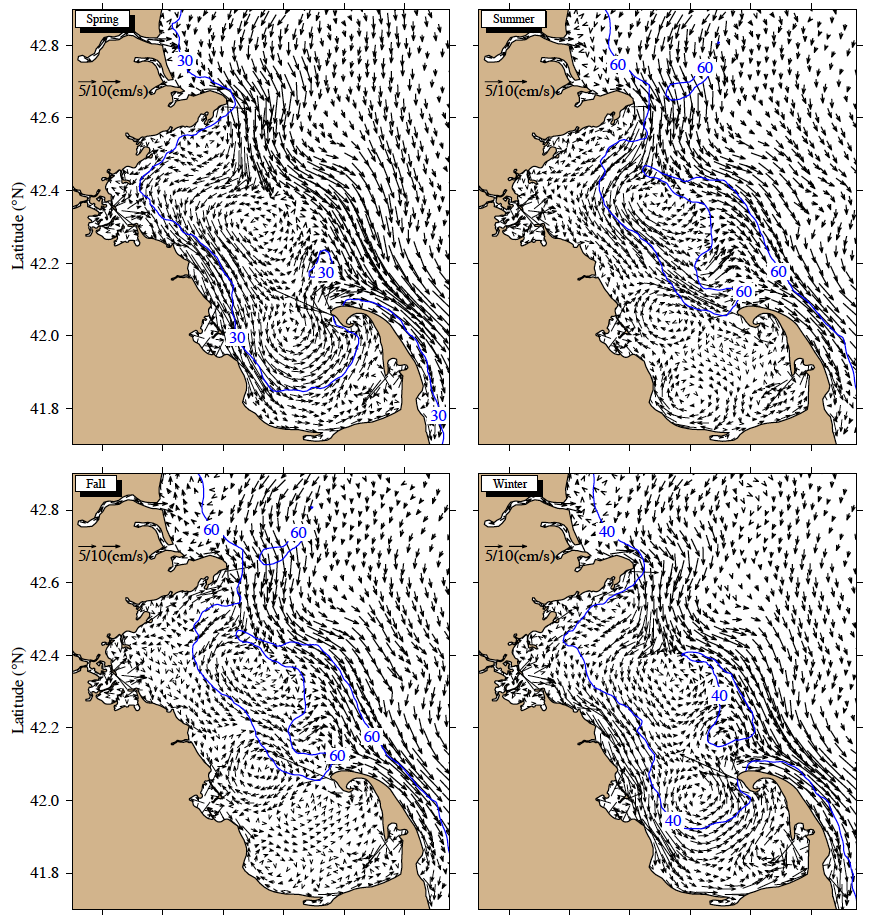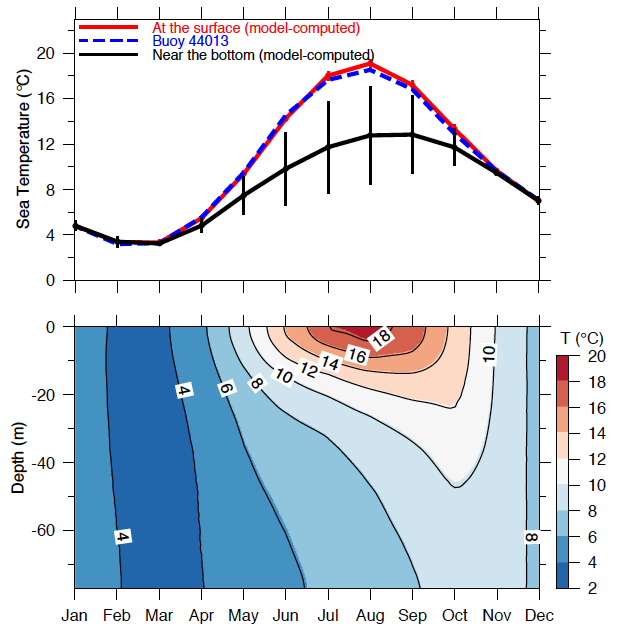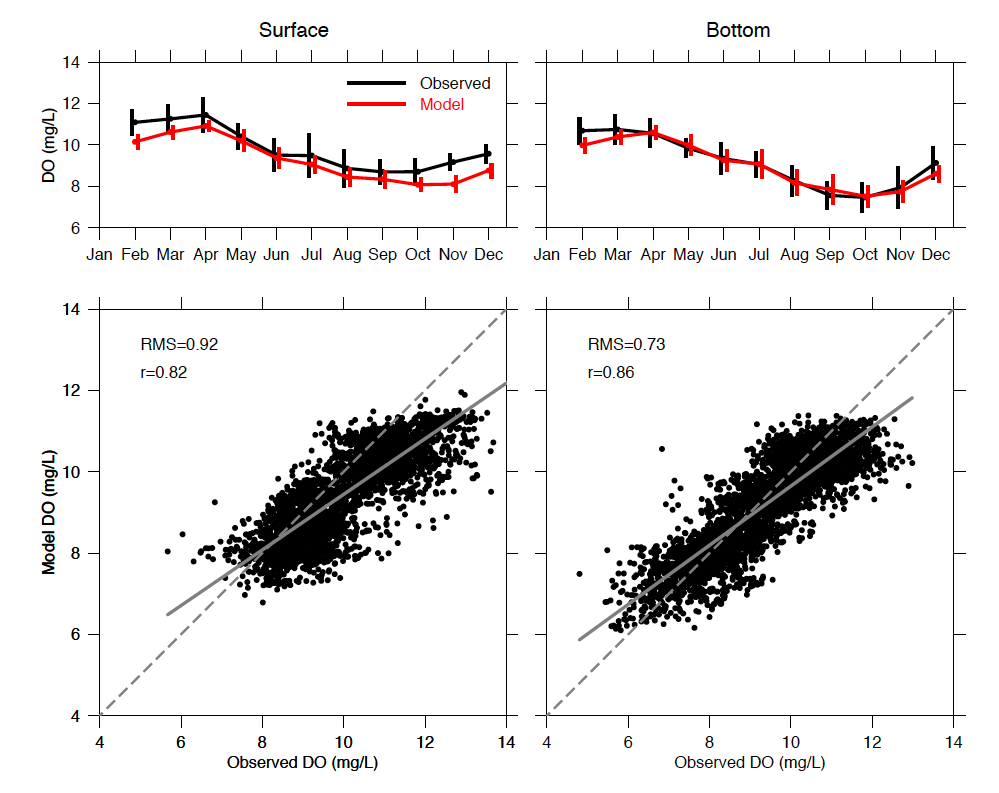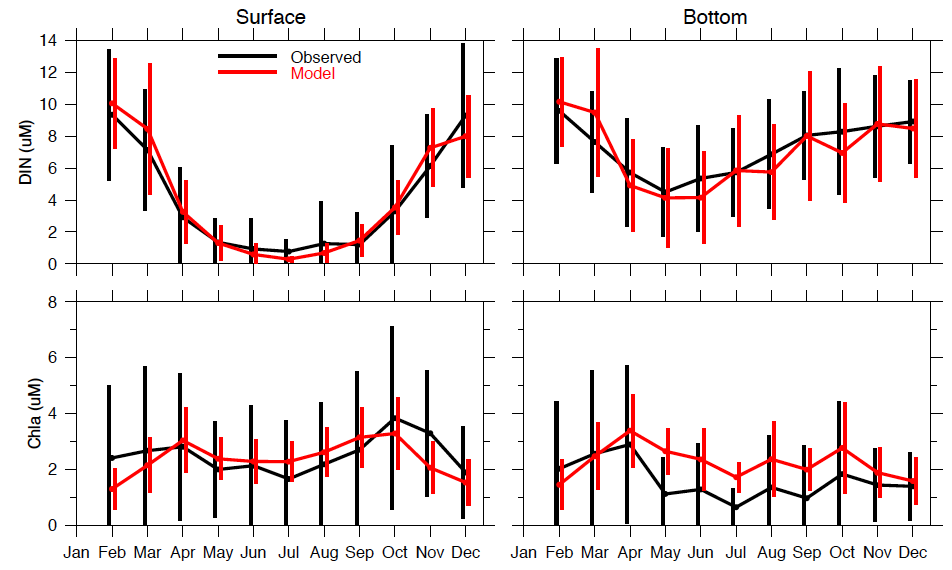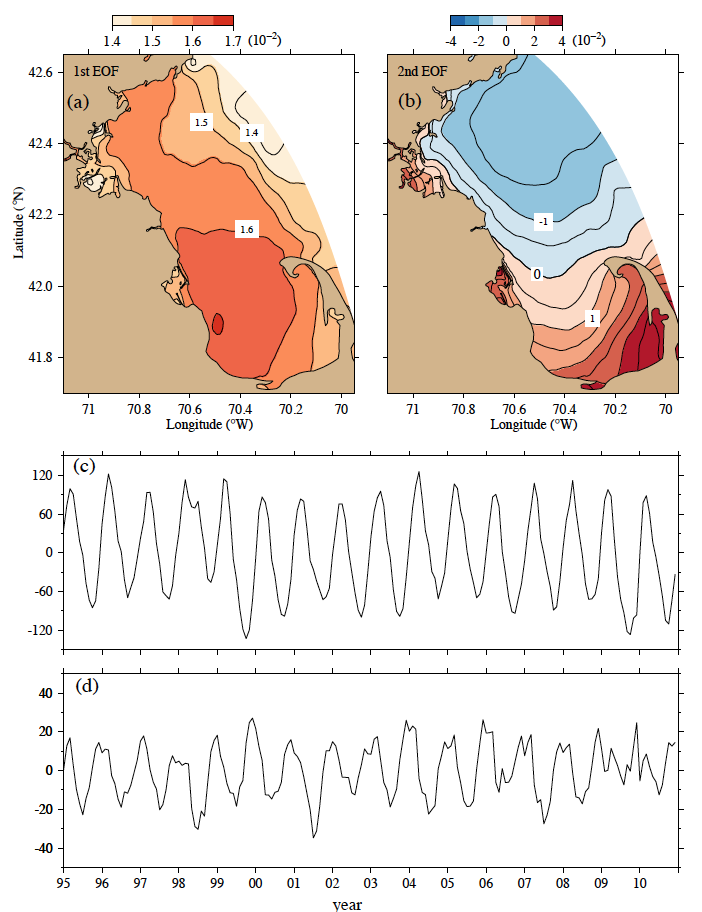Mass Bay is referred here to the entire semi-enclosed embayment system formed by Massachusetts Bay (MB) (defined as the northern region of Mass Bay between Cape Ann and Race Point) and Cape Cod Bay (CCB) (defined as the southern region of Mass Bay, south of Race Point), in the western Gulf of Maine (Fig. 1). The water depth in this bay ranges from a few meters near the coast to more than 90 m near the boundary. The major circulation in Mass Bay features an anti-clockwise gyre with an inflow from the upstream north near Cape Ann and an outflow through the south passage near the tip of Cape Cod [Bigelow 1927; Geyer et al. 1992]. The inflow is a continuous branch of the Western Maine Coastal Current (WMCC) together with freshwater discharge from the Merrimack River. After entering northern Mass Bay this flow separates into two branches: one moves southward along the local isobaths extending into CCB and another branch moves southeastward towards the southern outflow passage (Fig. 1). Inside CCB in the south, the water generally flows along the 20-40 m isobaths.
As a primary state variables used for water quality assessment, a long-term DO monitoring in Mass Bay has been conducted since the 90’s. These data showed a well-shaped seasonal cycle of DO in Mass Bay with the highest concentration during spring and lowest concentration during autumn (Fig. 2). This seasonal variation pattern has remained relatively steady over the last 18 years, with an interannual variation of only ~10% near the surface and bottom. Unlike DO, other primary state variables exhibited considerable interannual variability.
The distinct interannual variability exhibited by DO and other water quality variables raises a fundamental question: what are the key mechanisms controlling the seasonal and interannual variability of DO in Mass Bay?
- Water transport
- Water stratification and mixing
- Air-sea interaction (reaeration)
- photosynthesis, respiration
- Oxidation of organic matter
- Sediment oxygen demand (SOD)
Model study: FVCOM (Finite Volume Coastal Ocean Model)
High resolution Mass Bay FVCOM was nested to Gulf of Maine regional FVCOM model, and provides physical fields to drive the water qaulity model for Mass Bay that has a smaller domain with boundary shown in blue in Fig. 3, panel (A).
Mass Bay-FVCOM is a subdomain FVCOM that is nested within the regional Gulf of Maine (GoM) FVCOM (hereafter referred to as GoM-FVCOM) (Fig. 3). The computational domain of Mass Bay-FVCOM is configured with a non-overlapped triangular mesh, with a horizontal resolution varying from 0.3-0.5 km inside Boston Harbor to 9.0 km off the coast near the nesting boundary. Both Mass Bay-FVCOM and GoM-FVCOM uses the same hybrid vertical coordinate [Pietrzak et al. 2002], in which the water column is divided into 30 layers and the resolution is 1.0 m or less in the shallow regions.
A schematic of the RCA water quality model is shown in Fig. 4 [HydroQual 2004]. Biogeochemical variables include three phytoplankton assemblages (spring, summer and fall groups), four nutrients (ammonia, nitrate/nitrite, phosphate and dissolved silica), four organic phosphorus forms, four organic nitrogen pools, six organic carbon pools (four labile and refractory dissolved and particulate forms plus the reactive and exudates components), biogenic silica, dissolved and aqueous oxygen.
Simulated Circulation Pattern:
The model-computed flow was consistent with the conceptual circulation patterns shown in Fig. 1, which were based on previous measurements by Geyer et al. [1992]. With a high-resolution grid and better geometric fitting, Mass Bay-FVCOM provided much finer temporal and spatial structures of the circulation in this coastal region. Seasonal patterns of the circulation in Mass Bay clearly showed that the water exchange between MB and CCB was more active in winter through spring but very weak in summer through autumn. This feature resulted in a relatively “isolated” ecosystem with a longer residence time in CCB during summer through autumn, so that the key mechanisms controlling the DO variation could significantly differ in the northern and southern regions of Mass Bay in these two seasons.
Water seasonal stratification:
Water stratification and mixing in Mass Bay also exhibited clear spatial and temporal variability. In nearshore regions, as a result of wind and tidal mixing, waters remained vertically well mixed throughout the whole year, while in offshore regions, driven by seasonal heat flux variation, waters were strongly stratified during summer. The mixing depth can reach down to 80 m during the winter and be limited to the upper 10 m near surface during summer.
Model-Data Comparison for Dissolved Oxygen:
The model-computed monthly means of DO concentration over 1995-2010 were in good agreement with observations, not only in its value but also in its change over seasons (Fig. above, upper panel). Both model results and observed data showed the highest DO concentration in April, gradually decreased through May-September, and reached its minimum in October. The DO concentration increased again afterwards in winter and this increase lasted until next March-April, forming the seasonal cycle. The correlation between modeled and observed DO concentrations was 0.82 near the surface and 0.86 near the bottom, with a root-mean square (RMS) error of ~ 0.92 and ~ 0.73 mg/L, respectively (lower panel).
Model-Data Comparison for Dissolved Inorganic Nitrogen and Chlorophyll-a:
The model succeeded in simulating the dissolved inorganic nitrogen (DIN) concentration, not only in spatial distribution but also seasonal and interannual variations (Fig. above, upper panel). DIN was replenished in the winter-mixing season, during which the DIN concentrations at the surface and bottom were nearly the same. In surface waters, DIN concentrations started to decrease in March through April following spring phytoplankton blooms (Fig above, lower panel), and remained at a low level during summer through early fall as a result of strong stratification. Since the physical model successfully simulated vertical stratification and mixing, the water quality model was capable of resolving the observed large vertical gradient of DIN between the bottom and surface water, which was caused by the restriction of vertical water exchange under stratified condition. The model was also capable of capturing the rapid increase of DIN at the surface layer from October through December when the mixing process starts to strengthen during the wintertime.
The monitoring data showed that the phytoplankton biomass in Mass Bay was characterized by two seasonal blooms: the spring bloom in April and the fall bloom in October. The model successfully captured both spring and fall blooms in individual year simulations, but was incapable of reproducing the large interannual variability detected in the observations. One possible reason is that this water-quality model was developed without inclusion of harmful algae bloom (HAB) dynamics, which can cause a large short-term increase in near-surface Chl-a. In addition, although the model has made a great deal of efforts categorizing the phytoplankton species into three phytoplankton assemblages (spring, summer and fall groups), the cellular composition of Chl:C ratio is nearly impossible to be accurately represented in the model at current stage due to the complexity of phytoplankton species in this region.
EOF analysis of DO variability:
An empirical orthogonal function (EOF) analysis was performed to synthesize the temporal and spatial fluctuations in DO concentration in Mass Bay. Singular value decomposition was used to obtain the dominant EOF modes and principal components. To focus on seasonal and interannual variability, the EOF analysis was done using monthly-averaged fields, with no attempt to resolve higher frequency variability with time scales shorter than one month.
The EOF analysis on the 16-year simulation DO fields produced two dominant modes that account for 98.6% of the total variance of DO concentration. The 1st EOF mode represents the seasonal cycle and accounted for 94.3% of the total variance. The amplitudes of this mode have the same sign (all positive) and were in a range of 1.4-1.7. Combined with the corresponding amplitude time series , we can see that the dominant variation in DO concentration over the entire Mass Bay was primarily characterized by seasonal variability, with the highest concentrations occurring in spring and lowest in fall, consistent with observations. This seasonal variability exhibited larger amplitude in the southern region (CCB) than in the northern region (MB) (Fig. above panel a). The amplitude time series also exhibits significant interannual variations. For example, DO concentrations during the fall season were lower in 1999 than in other years, in agreement with monitoring data reported by Libby et al. [2007]. The 2nd EOF mode accounted for 4.3% of the total DO variance and had opposite signs in the northern (MB) and southern (CCB) regions. (Fig. above, panel b). This suggests that there was a secondary spatial pattern with opposite phase in these two regions. The corresponding amplitude time series showed a phase-shift relative to the 1st EOF mode, with peaks appearing in winter and troughs in summer. A phase-leading feature in CCB can be reproduced by a superposition of the 2nd mode on the 1st mode. Since these two modes implied different characteristics, this suggests that the DO variations in the southern and northern regions were driven by different dynamics. The process-oriented experiments described in the next section were aimed at addressing this question.
Diagnostic Experiments:
In order to examine the roles of advective and local biogeochemical processes in DO variation in Mass Bay, we performed four diagnostic experiments to identify and qualify relative contributions of these processes. Since the interannual variation of DO was small, we selected one year (2008) as representative and ran UG-RCA model by turning off: a) the air-sea oxygen exchange process (Ex#1); b) the oxygen production and consumption through photosynthesis minus respiration, organic matter oxidation and nitrification (Ex#2); c) the SOD (Ex#3); and d) all biogeochemical processes (Ex#4). A comparison of monthly-mean DO profiles for these four experiments was made at station F17 in MB and station F02 in CCB...To see the completed analysis of this research, click here
The highlights:
- A coupled physical-biogeochemical model was developed to simulate the DO field in Mass Bay.
- DO in Mass Bay exhibits a well-defined seasonal cycle, highest in March-April and lowest in October.
- An EOF analysis indicates that DO in Mass Bay features both seasonal and spatial modes.
- Horizontal advection plays a dominant role in the DO variability in the northern region.
- The southern region features a well-defined local retention mechanism with a longer residence time, where the DO variation is controlled predominantly by local biogeochemical processes.


